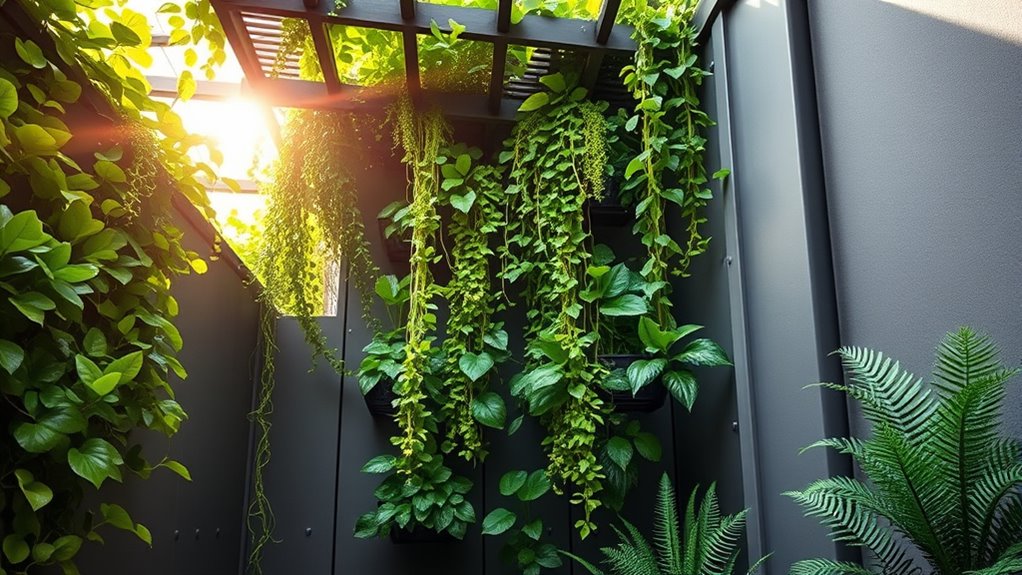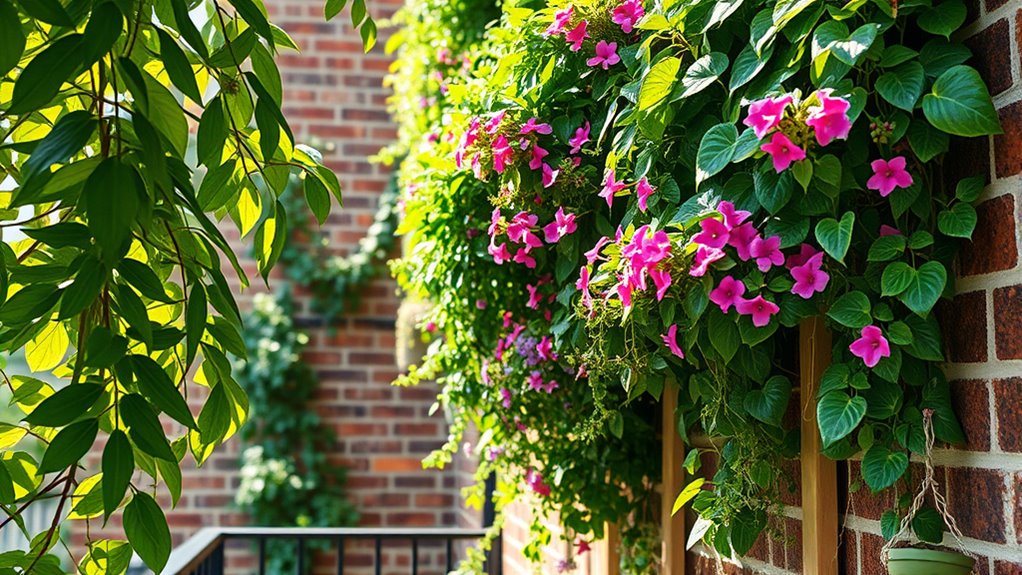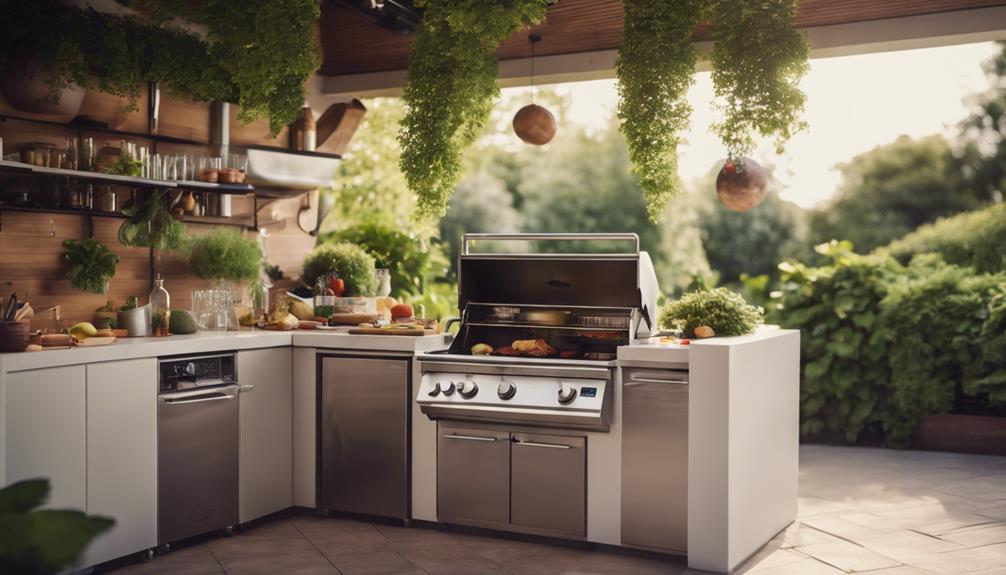Vertical gardens are a fantastic way to maximize small outdoor spaces by turning blank walls into lush, vibrant displays. You can choose from various designs like planters, panels, or trellises to suit your style, whether modern or jungle-inspired. Selecting the right plants—such as succulents or ferns—based on your climate and sunlight can create a thriving, low-maintenance oasis. Keep an eye on plant growth and watering strategies, and you’ll have a lush retreat in no time. Discover more to optimize your vertical garden!
Key Takeaways
- Use vertical wall panels or trellises to maximize greenery in limited outdoor space.
- Select compact, climate-appropriate plants like succulents or shade-tolerant greenery.
- Incorporate diverse textures and colors for visual interest and depth.
- Choose low-maintenance plants and efficient watering systems to simplify upkeep.
- Plan layout and container choices to match your aesthetic, whether modern or lush jungle style.

Vertical gardens transform blank walls into lush, living displays that enhance any space. If you’re working with a small outdoor area, these gardens offer an innovative way to maximize your space while adding vibrant greenery. When planning your vertical garden, you’ll want to focus on garden design and plant selection to guarantee your setup is both beautiful and sustainable. Thoughtful garden design helps you determine the best layout, choosing whether to create a symmetrical pattern or a more organic, free-flowing arrangement. Consider the overall aesthetic you want to achieve—whether it’s modern minimalism or a lush, jungle vibe—and select containers, planters, or panels that complement your style. The design should also account for practical aspects, like ease of watering and maintenance, so your vertical garden remains healthy and thriving over time. Incorporating personal growth principles such as patience and adaptability can help you enjoy the process of nurturing your garden and overcoming potential challenges.
Plant selection is vital for a successful vertical garden, especially in small outdoor spaces. You’ll want to choose plants that are well-suited to your climate, sunlight exposure, and the specific conditions of your wall. For instance, if your wall gets full sun, opt for sun-loving plants like succulents, herbs, or certain flowering varieties. If shade dominates, consider ferns, mosses, or shade-tolerant leafy greens. When selecting plants, think about their growth habits—will they vine, cascade, or remain upright? Vining plants like pothos or climbing roses can efficiently cover vertical surfaces, creating a lush curtain of greenery. Cascading plants such as ivy or trailing begonias spill over containers, softening the edges and adding visual interest. Keep in mind the mature size of each plant to prevent overcrowding and guarantee they have enough space to grow healthily.
In terms of plant diversity, mix different textures, colors, and leaf shapes to create a dynamic, engaging display. Combining flowering plants with foliage varieties adds depth and visual appeal. Regular maintenance is essential, so choose low-maintenance options if you prefer minimal upkeep. Remember to incorporate suitable watering systems—drip irrigation or self-watering planters can make your gardening routine easier. As you refine your vertical garden, pay attention to how the plants grow and adjust your plant selection or design as needed. With the right approach to garden design and plant selection, your small outdoor space can become a lush, vibrant retreat that feels much larger and more inviting.
Frequently Asked Questions
What Are the Best Plants for Shaded Vertical Gardens?
For shaded vertical gardens, you should choose shade plants and low light greenery that thrive without direct sunlight. Consider ferns, such as maidenhair or Boston fern, which add lush texture. Pothos and philodendrons also do well in low light conditions, offering vibrant foliage. Peace lilies and certain begonias are great options too. These plants adapt well to shaded vertical spaces, creating a lively, green display even in low-light environments.
How Much Maintenance Do Vertical Gardens Require?
You’ll find vertical gardens require a fair share of attention, but they’re worth the effort. Typically, you’ll need to water them about 2-3 times a week, adjusting for weather and plant type. Keep pests at bay with regular checks and natural pest control methods. Pruning and fertilizing are also essential, so stay on top of maintenance to keep your garden thriving. It’s a labor of love, but the results speak for themselves.
Can Vertical Gardens Be Installed Indoors?
Yes, you can install vertical gardens indoors. You’ll need to guarantee proper indoor lighting, like grow lights, to keep your plants healthy. Regular pest control is essential to prevent infestations, especially in enclosed spaces. Keep an eye on humidity and watering needs, adjusting as necessary. With the right setup, your indoor vertical garden will thrive, adding greenery and fresh air to your living space.
What Is the Average Cost of Setting up a Vertical Garden?
The average cost of setting up a vertical garden ranges from $200 to $2,000, depending on the size and materials used. You should consider a cost breakdown that includes framing, plants, soil, and irrigation systems. For effective budget planning, determine your space, decide on plant types, and choose affordable materials if you’re on a tight budget. This way, you can create a beautiful vertical garden without overspending.
How Do I Water My Vertical Garden Efficiently?
You should use a drip irrigation system or self-watering systems to water your vertical garden efficiently. These systems deliver water directly to plant roots, reducing waste and ensuring consistent moisture. Set up timers with your drip system to automate watering, especially when you’re away. Regularly check the moisture levels and adjust your system as needed. This approach keeps your plants healthy while saving water and effort.
Conclusion
So, now you know that vertical gardens are the ultimate solution for tiny outdoor spaces—because who needs ground space when you can have a wall covered in greenery? With a little effort, you’ll become the envy of all your neighbors, turning your boring wall into a lush jungle where no one dares to disturb your botanical paradise. Just think: you’ll be the person who proved that even small spaces can grow big, leafy dreams.










